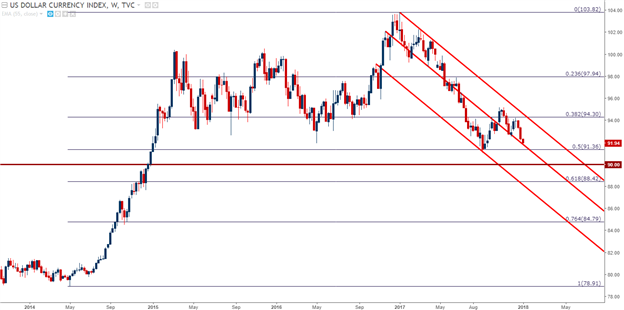The U.S. Dollar set a 14-year high on January third of a year ago. From that point forward, we've seen a fierce inversion in the Greenback that is wiped away as much as - 12.3% of the money's esteem. - This continuation of USD-shortcoming has impelled EUR/USD over a key mental level at 1.2000. This was a major region of protection in the match a year ago, yet after a help check there yesterday, the possibility of bullish continuation remains. The U.S. Dollar's down-slant simply commended a birthday. It was only a year and a day back that DXY set a new 14-year high at 103.82. As we came into a year ago, little hoped to obstruct the Greenback's bullish rising, as the 'Trump Trade' otherwise known as the 'reflation exchange' kept on driving financial specialists into U.S. resources of both a value and money assortment. Yet, that high that was determined to January third was not to be tried once more, as venders started to appear in January, and stayed responsible for USD value activity for basically all of 2017. This bearish drive saw as much as - 12.3% of the Greenback's esteem eradicated when a low was set in September; and given this is a move in a non-levered cash, that is an incredible difference in pace.
In any case, after that low was set in September, a touch of expectation started to work around Dollar bulls as USD spent the following two months exchanging higher: But subsequent to wavering at the 95.00 level, bears returned and have stayed in-constrain from that point onward. This week saw DXY hole lower, and that shortcoming has kept on appearing as value activity is peeling towards the 2017 low which is likewise the three year low in DXY.
The unavoidable issue now is whether we see some component of reaction at these three-year-lows. The skip that appeared in September occurred around a key level. The cost of 91.36 is the half Fibonacci retracement of the 2014-2017 bullish move. This offered ascend to the potential for 2017 being some component of absorption in a more drawn out term topic of USD-quality; however in the event that we take that level out, there is small obstructing a keep running towards the mental level of 90.00.Complicating the possibility of going up against bearish presentation in the Greenback right now is the way that we're sitting at here and now bolster, around a level that had held the lows on Tuesday and Wednesday. For brokers hoping to go up against short-side positions in the U.S. Dollar, anticipating a trial of protection could be a considerably more satisfactory method for moving toward issues, and on the beneath two-hour diagram, we've included three potential levels of enthusiasm up to 92.50, which was the November swing-low.

